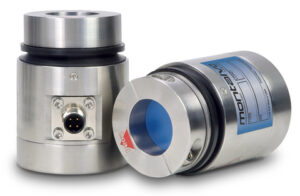When installing your ES Series Dead Shaft-Idler load cells there are a few key considerations to ensure proper installation. Follow the provided installation instructions with your components, but if you are experiencing some issues, check the following:
Idler Roll Support
The load cells should be supporting the roll as if the roll were attached directly to the machine frame. If the idler roll is not completely supported by the load cell you will run into issues. This is typically caused by either the idler roll dead-shaft being too short, or the shaft diameter is not the same size as the load cell coupling. If you have a shaft size diameter that is not the same size as the load cell coupling Montalvo does supply bushings to ensure the shaft properly fits into the load cell. Contact us for more information.
Heavy Idler Roll
When selecting the correct load rating for your load cells, the weight of the idler roll must be accounted for. The load on the load cells is determined by the web tension, the wrap angle (how much of the idler roll is contacted by the material as it passes over the roller), the direction of force due to web tension, and the weight of the idler roll. If you are utilizing a pair of 50 lb (22kg) rated load cells (meaning their maximum is 50 lbs each) and your idler roll weighs 50 lbs, you effectively only have half of the load cells capacity left to account for the three other factors contributing to the total load. When sizing a load cell it is always recommend that you discuss your process with a Montalvo Applications Specialists to ensure the load cells are properly sized based on all of your process variables.
Uniform Mounting
A critical step in installation is to ensure that both load cells are mounted the same way in respect to the direction of force. Montalvo ES load cells are labeled with a “force arrow” indicating how the load cell should be mounted. The arrow should be aimed in the direction of force due to web tension. If one load cell is aiming in one direction and the other load cells is aiming in another direction then you may receive signal errors, and the load cells could be operating at less than optimum efficiency.



